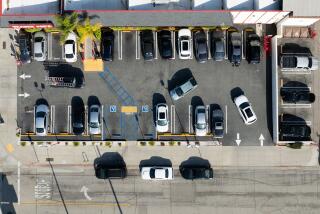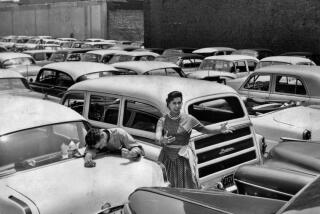Giant SUVs Are Tight Squeeze in Mall Parking Lots
- Share via
Who among us hasn’t been trapped in the caravans of frazzled holiday shoppers circling crowded malls and shopping centers in search of a parking spot? You know it’s not a festive sight.
Finding a parking space this time of year is already tough, even if you’re driving a Volkswagen Bug. But if you are navigating a massive sport-utility vehicle such as the new Ford Excursion--which weighs nearly 4 tons and measures 19 feet long, 6 1/2 feet wide and nearly 7 feet tall--the challenge is even greater.
Forget trying to squeeze into compact-car spaces, which are only about 8 feet by 15 feet; docking the larger SUVs into a standard-size spot is difficult enough. That’s why you sometimes see them taking up nearly two full spaces.
Mid-size SUVs, such as the Chevy Blazer and Ford Explorer, can fit relatively comfortably in a standard, one-size-fits-all space of 8 1/2 feet by 18 feet. But the bigger models--the Chevy Suburban and the previous largest entry in the Ford lineup, the Expedition--not only encroach on neighboring spots, but they also create hazards by blocking visibility and extending into the driving lanes.
Some of these giant SUVs can’t even squeeze through the entrances of low-hanging parking structures.
“We’ve had them get stuck trying to drive in,” says Omar Flores, facilities manager at the Beverly Center in Los Angeles. “If they’re stuck, we have to get our personnel--two people on each side--to lift the bar and allow the car to progress forward.” The same process has to be repeated when the vehicle leaves.
Some SUV drivers haven’t waited for help and have just plowed through, scraping the tops of their vehicles, Flores says.
*
Although SUVs account for about one in five new vehicles sold in the United States, the largest of them represent a small percentage of all cars and trucks on the road today.
Nevertheless, says traffic consultant Gary Hamrick of Meyer, Mohaddes Associates in Los Angeles, “if people keep buying these larger vehicles, it will absolutely be an issue that cities would have to deal with in their ordinance codes.”
Municipal officials may have to consider such measures as enlarging standard parking spaces, widening traffic aisles or eliminating all compact-car spaces, Hamrick says.
Indeed, some businesses and communities have already begun taking action.
In upscale La Canada Flintridge, where there is an abundance of large SUVs such as the luxury-class Lincoln Navigator and Mercedes ML430, one popular shopping center repainted the stripes in its parking lot to create wider spaces. But in doing so, the total number of spots was reduced, to the chagrin of other drivers.
At South Coast Plaza in Costa Mesa, management has dealt with heavy holiday traffic by requiring the estimated 5,000 employees to park off-site to free more spaces for customers. Four valet stations and high parking garage clearances have kept problems at bay, says Debra Gunn Downing, executive director of marketing.
Nearly a decade ago, Long Beach rescinded a municipal ordinance that required developers to provide a set percentage of compact spaces, says Bob Benard, the city’s zoning officer.
“There was a problem because people were parking big cars in the compact spaces,” he says.
Now, Long Beach, like some other cities, requires a one-size-fits-all space.
“That seemed to have solved the problem up until recently,” when the huge SUVs began gaining in popularity, Benard says.
Jeanne Wright cannot answer mail personally but responds in this column to automotive questions of general interest. Write to Your Wheels, Business Section, Los Angeles Times, Times Mirror Square, Los Angeles, CA 90053. E-mail: highway1@latimes.com.






